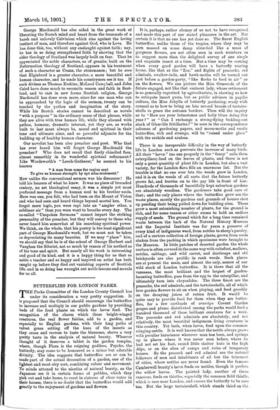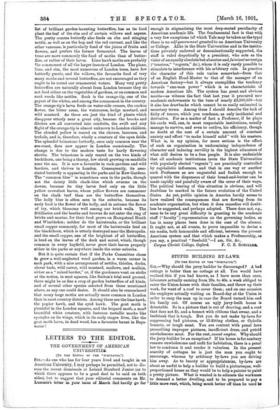BUTTERFLIES FOR LONDON PARKS.
nrIHE Parks Committee of the London County Council has
under its consideration a very pretty suggestion. It is proposed that the Council should encourage the butterflies to increase and multiply in our public gardens by providing beds of the food plants on which the larvie feed. The recognition of the charm which these bright-winged creatures, the real flower fairies, add to a garden, and especially to English gardens, with their long paths of velvet grass setting off the hues of the insects as they cross and recross to taste the blossoms, shows a very pretty taste in the analysis of natural beauty. Whoever thought of it deserves a tablet in the garden temples, where, though Flora is the reigning goddess, Psyche, the butterfly, may come to be honoured as a minor but adorable divinity. The idea suggests that butterflies are or can be made part of the actual decoration of a garden, one of the lightest and most airy sort, combining colour and movement. To minds attuned to the niceties of natural beauty, as the Japanese see it in certain forms of pebbles, which they pick out and take home, to reset in cisterns of clear water in their houses, there is no doubt that the butterflies would add greatly to the enjoyment of gardens and flowers.
It is, perhaps, rather clumsy of us not to have recognised and made this part of our stated pleasures in the art. But certain it is that no one has yet done so. The finest English butterflies, unlike those of the tropics, where they may be seen massed on some damp river-bed like a mass of gorgeous flowers, are not often seen in such numbers as to suggest more than the delighted survey of one single and exquisite insect at a time. But a time may be coming when every good garden will have a butterfly rearing house, like that at the "Zoo," and flights of peacocks, red admirals, swallow-tails, and hawk-moths will be turned out just before a garden-party, "like flocks to feed in air" or on the flowers. We can picture the Miss Ormerods of the future engaged, not like that eminent lady, whose retirement is so generally regretted by agriculturists, in showing us how to extirpate insect pests, but as public advisers in papilio culture, the Miss Jekylls of butterfly gardening, ready with counsel as to how to bring on into second broods of tortoise- shells to grace the autumn borders. Then will the inquiry as to "How are your brimstones and holly blues doing this year ? " or "Can I exchange a strong-flying bedding-out stock of Glanville fritillaries ? " be seen in the correspondence columns of gardening papers, and moon-moths and exotic butterflies, rich and strange, will be "raised under glass" with the orchids and azaleas.
There is no insuperable difficulty in the way of butterfly life in London such as prevents the increase of many birds. All their " larva3" (no one properly in the " fancy " calls them caterpillars) feed on the leaves of plants, and there is not only a great quantity of plant life in London, but also a vast variety, for the London flora fills an enormous list. But the trouble is that no one ever lets the weeds grow in London, and it is on the weeds of all sorts that the future butterfly grows fat, and hurries on to the gay life in front of him. Hundreds of thousands of beautifully kept suburban gardens are absolutely weedless. The gardeners take good care of that; and the only places where the butterflies grow are the waste places, mostly the gardens and grounds of houses shut up pending their being pulled down for building sites. These grow a most astonishing number of plants, for the ground is rich, and for some reason or other seems to hold an endless supply of seeds. The ground which for a long time remained waste between the back of the Natural History Museum and the Imperial Institute was for years a preserve of every kind of indigenous weed, from nettles to sheep's parsley, and of a curious collection of foreign plants, grown from seeds shaken from the packing in which specimens were brought to the Museum. In little patches of deserted garden the whole surface is often covered in the same way with coltsfoot, mallows, nettles, cabbage, and wild carrot, and dustheaps and old brickyards are also prolific in rank weeds. Such places are at present the main, and almost the only, source of our wild stock of London butterflies. It is there that all the vanesaas, the most brilliant and the largest of garden- haunting butterflies, pass from the egg to the caterpillar, and ultimately turn into chrysalides. The three finest are the peacocks, the red admirals, and the tortoiseshells, all of which love garden flowers to sit on when playing, and feed greedily on the decaying juices of rotten fruit. It would be quite easy to provide food for them when they are butter- flies, for a few cartloads of overripe Covent Garden grapes and plums distributed among the parks would feed a hundred thousand of these brilliant creatures for a week. The peacocks and red admirals are absolutely, and not relatively, the most beautiful indigenous living creatures in this country. Yet both, when larvae, feed upon the common stinging-nettle. It is well known that the nettle always grows with peculiar luxuriance wherever man has been, and springs up in places where it was never seen before, where he had not set his foot, round little shelter huts in the high Alps, or on the sites of camps and ruins of temporary houses. So the peacock and red admiral are the natural followers of men and inhabitants of all but the trimmest of cities, where nettles are never found. Even the famous Camberwell beauty's larva feeds on nettles, though it prefers the willow leaves. The painted lady, another of these vanessas, feeds on thistles, especially the common field thistle, which is rare near London, and causes the butterfly to be rare too. But the large tortoiseshell, which stands third on the
list of brilliant garden-haunting butterflies, has as its food plant the leaf of the elm and of certain willows and aspens. The pretty comma butterfly also feed's on elm and stinging nettle, as well as on the hop and the red currant, and like the other vanessas, is particularly fond of the juices of fruits and flowers, and prefers the former fermented. The leaves of trees are more commonly the food of moths than of butter- flies, or rather of their larva. Lime hawk moths are probably the commonest of all the larger insects of London. The plane, lime, and elm, the most numerous of London trees, have few butterfly guests, and the willows, the favourite food of very many moths and several butterflies, are not encouraged as they ought to be round our ornamental waters. Many very pretty butterflies are naturally absent from London because they do not feed either on the vegetables of gardens, or on common and rank weeds like nettles. Such is the orange-tip, one of the gayest of the whites, and among the commonest in the country. The orange-tip's larva feeds on water-side creases, the cuckoo flower, the bitter cress, the watercress, hedge mustard, and wild mustard. As these are just the kind of plants which disappear utterly near a great city, because the brooks and ditches are all converted into conduits, the swift and airy flight of the orange-tip is almost unknown to London children. The clouded yellow is reared on the clovers, lueernes, and trefoils, and is, therefore, wholly a creature of the open fields. The splendid brimstone butterfly, once only common near the sea-coast, does now appear in London occasionally. The change is due to the modern taste for hardy flowering shrubs. The brimstone is only reared on the two kinds of buckthorn, one being a thorny, low shrub growing on sandhills near the sea. It is now a favourite in rock-gardens and wild borders, and thrives in London. Consequently, its ,asso- dated butterfly is appearing in the parks and in Kew Gardens. The "common blue" is sometimes seen in the parks, though not the dainty little chalk-blue which swarms on the downs, because its tiny lame feed only on the little yellow crowsfoot leaves, whose yellow flowers are commoner on the chalk turf than are the butterflies themselves. The holly blue is often seen in the suburbs, because its early food is the flower of the holly, and in autumn the flower of ivy, which blossoms well among our brick walls. The fritillaries and the heaths and browns do not enter the ring of bricks and mortar, for their food grows on Hampstead Heath and Wimbledon; neither do the hairstreaka, or the brilliant small copper commonly, for most of the hairstreaks feed on the blackthorn, which is utterly destroyed near the Metropolis, and the small copper, one of the brightest of all butterflies, is bred on the leaves of the dock and sorrel, which, though common in every hayfield, never grow their, leaves properly either in the parks or anywhere inside the outer suburbs.
But it is quite certain that if the Parks Committee chose to grow a well-neglected weed garden, in a warm corner in each park, with a nice arrangement of nettles, thistles, docks, clover buds, wild carrot, wild mustard, mallows, and mullein, either as a "mined border," or, if the gardeners went on strike at the notion, in neat squares, like Sutton's trial seed ground, there might be as fine a crop of garden butterflies of all kinds, and of several other species selected from those mentioned above, as any one could desire. It should also be remembered that many large moths are actually more common in London than in most country districts. Among these are the lime hawk, the poplar hawk, and the eyed hawk. The goat moth is plentiful in the London squares, and the leopard moth, a most beautiful white creature, with lustrous metallic marks like spangles on its wings, which in its early stages lives, like the goat moth larva, in dead wood, has a favourite haunt in Bays- water !







































 Previous page
Previous page